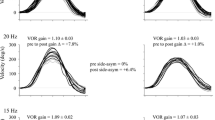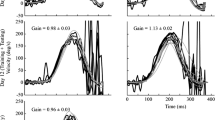Summary
Reversing vision in the horizontal (left-right) plane in humans induces adaptive mechanisms and even reversal of the horizontal vestibulo-ocular reflex (HVOR). The present experiments were aimed at investigating if such adaptive modifications could be observed in the frontal plane by reversal of the torsional visual world movements. Torsional vestibulo-ocular reflex (TVOR) was measured in one subject who wore Dove prisms for 19 days. The gain of TVOR was tested in the dark with the head leaned backward and rotating around an earth vertical axis with sinusoidal rotation (1/6 Hz). The gain decreased from 0.27 to 0.13 at 70 ° peak-to-peak amplitude, and from 0.3 to 0.11 at 45 ° peak-to-peak amplitude after 19 days of prism-wearing. Full gain recovery was observed 10 days after prism removal. The results are compared with the observation that in the same situation the vertical VOR (up-down) is not reversed (Dove prisms do not reverse visual images in this plane). As the same four (vertical) canals produce both reflexes, it is suggested that central neuronal mechanisms allow the recognition of the geometrical pattern of visual reversals and selectively adapt the reflex in the relevant planes.
Similar content being viewed by others
References
Anderson JH, Precht W (1979) Otolith responses of extra-ocular muscles during sinusoidal roll rotations. Brain Res 160: 150–154
Baker R, Berthoz A (1974) Organisation of vestibular nystagmus in the oblique oculomotor system. J Neurophysiol 37: 195–217
Benson AJ, Guedry FE, Melvill Jones G (1970) Response of semicircular canal dependent units in vestibular nuclei to rotation of a linear acceleration vector without angular acceleration. J Physiol (Lond) 210: 475–494
Berthoz A (1974) Contrôle vestibulaire des mouvements oculaires et des réactions d'équilibration chez le chat. Thèse Université Paris VI. Docteur Es Sciences, Paris, p 145
Collewijn H, Grootendorst AF (1979) Adaptation of optokinetic and vestibulo-ocular reflexes to modified visual input in the rabbit. In: Granit R, Pompeiano O (eds) Reflex control of movement and posture. Elsevier, Amsterdam (Prog Brain Res 50: 771–781)
Davies PT, Melvill Jones G (1976) An adaptive neural model compatible with plastic changes induced in the human vestibulo-ocular reflex by prolonged optical reversal of vision. Brain Res 103: 546–550
Davies T, Merton PA (1958) Recording compensatory rolling of the eyes. J Physiol (Lond) 140: 27P
Dichgans J, Held R, Young L, Brandt T (1972) Moving visual scenes influence the apparent direction of gravity. Science 178: 1217–1219
Gonshor A (1974) An investigation of plasticity in the human vestibulo-ocular reflex arc. PhD Thesis, McGill University, Montreal
Gonshor A, Melvill Jones G (1971) Plasticity in the adult human vestibulo-ocular reflex arc. Proc Can Fed Biol Soc 14: 11
Gonshor A, Melvill Jones G (1976a) Short term adaptive changes in the human vestibulo-ocular reflex arc. J Physiol (Lond) 256: 361–379
Gonshor A, Melvill Jones G (1976b) Extreme vestibulo-ocular adaptation induced by prolonged optical reversal of vision. J Physiol (Lond) 256: 381–414
Graf W, Simpson JI (1981) The relation between the semi-circular canals, the optic axes and the extraocular muscles in lateral eye and frontal eye animals. In: Fuchs A, Becker W (eds) Progress in oculomotor research. Elsevier, Amsterdam, in press
Ito M (1979) Adaptive modification of the vestibulo-ocular reflex in rabbits affected by visual inputs and its possible neuronal mechanisms. Prog Brain Res 50: 757–761
Ito M, Shiida T, Yagi N, Yamamoto M (1974) Visual influence on rabbit's horizontal vestibulo-ocular reflex that presumably is effective via the cerebellar flocculus. Brain Res 75: 170–174
Keller EL, Precht W (1979) Adaptive modification of central vestibular neurons in response to visual stimulation through reversing prisms. J Neurophysiol 42: 896–911
Lisberger SA, Miles FA (1980) Role of primate medial vestibular nucleus in long term adaptive plasticity of vestibulo-ocular reflex. J Neurophysiol 43: 1725–1745
Meiry JL (1966) The vestibular system and human dynamic space orientation. Washington, Nasa CR-628
Melvill Jones G (1963) Ocular nystagmus recorded simultaneously in three orthogonal planes. Acta Otolaryngol (Stockh) 56: 619–631
Melvill Jones G (1966) Interactions between optokinetic and vestibulo-ocular responses during head rotation in various planes. Aerosp Med 37: 172–177
Melvill Jones G (1970) Origin significance and amelioration of Coriolis illusions from the semicircular canals. A non-mathematical appraisal. Aerosp Med 41: 483–490
Melvill Jones G (1977) Plasticity in the adult vestibulo-ocular reflex arc. Philos Trans R Soc Lond [Biol] 278: 319–334
Melvill Jones G, Drazin DH (1962) Oscillatory motion in flight. In: Barbour AB, Whittingham HE (eds) Human problems of supersonic and hypersonic flight. Pergamon Press, London, pp 134–151
Melvill Jones G, Mandl G (1979) Effects of stroble light on adaptation of vestibulo-ocular reflex (VOR) to vision reversal. Brain Res 164: 300–303
Melvill Jones G, Barry W, Kowalski N (1964) Dynamics of the semi-circular canals compared in yaw, pitch and roll. Aerosp Med 35: 984–989
Miles FA, Fuller JH, Braitman DJ, Dow BM (1980) Long term adaptive changes in primate vestibulo-ocular reflex. III. Electrophysiological observations in flocculus of normal monkeys. J Neurophysiol 43: 1437–1476
Precht W (1979) Labyrinthine influence on the vestibular nuclei. In: Granit A, Pompeiano O (eds) Reflex control of posture and movement. Elsevier, Amsterdam (Prog Brain Res 50: 369–381)
Robinson DA (1976) Adaptive gain control of the vestibulo-ocular reflex by the cerebellum. J Neurophysiol 39: 954–969
Robinson DA (1978) Vestibular and optokinetic symbiosis. An example of explaining by modelling. In: Baker R, Berthoz A (eds) Control of gaze by brain stem interneurons. Elsevier, Amsterdam, pp 49–58
Uchino Y, Hirai N, Watanabe S (1979) Vestibulo-ocular reflex from the posterior canal nerve to extraocular motoneurons in the cat. Exp Brain Res 32: 377–389
Wilson VJ, Melvill Jones G (1979) Mammalian vestibular physiology. Plenum Press, New York
Author information
Authors and Affiliations
Additional information
Supported by CNRS Greco 17 funds
Supported by Canadian Medical Research Council and McGill Hosmer Research Fund
Supported by a D.G.R.S.T. fellowship
Rights and permissions
About this article
Cite this article
Berthoz, A., Melvill Jones, G. & Bégué, A.E. Differential visual adaptation of vertical canal-dependent vestibulo-ocular reflexes. Exp Brain Res 44, 19–26 (1981). https://doi.org/10.1007/BF00238745
Received:
Issue Date:
DOI: https://doi.org/10.1007/BF00238745




